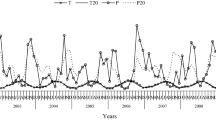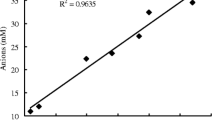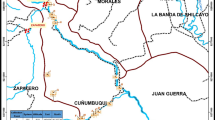Abstract
Phosphorus (P) losses from sandy soils that are predominant in the 1.4 million ha of pastureland in Florida are a major cause of water pollution. We hypothesized that soil P loss would be lower from silvopastoral systems than from treeless pastures because soil P removal by a combined stand of trees and pasture would be more than that of treeless pasture. Four slash pine (Pinus elliottii Engelm.) + bahiagrass (Paspalum notatum Flüggé) silvopastoral systems located in Alachua, Suwannee, Manatee, and Osceola counties in Florida were selected for the study. The former two sites are on Ultisols, and the latter two on Spodosols. Soil samples were collected at different depth increments. Soil P storage capacity (SPSC), the maximum amount of P that can be safely applied to a soil before it becomes an environmental concern, was calculated. Water-soluble P concentrations in the 0–5 cm soil layer ranged from 4 to 11 mg kg−1 for the silvopasture sites and 10 to 23 mg kg−1 in the treeless pasture sites, with higher P concentrations in the treeless pasture at each location. Total SPSC in the upper 1 m depth ranged from 342 to 657 kg ha−1 in the silvopasture sites and −60 to 926 kg ha−1 in the treeless pasture sites (a negative value indicates that the soil is a P source). The results suggest that P buildup within the soil profile and therefore the chances for loss of P from soil to water bodies were less from silvopastures than from treeless pastures. Thus, silvopasture systems can be expected to provide greater environmental service in regard to water quality protection compared to treeless pastures under comparable ecological settings


Similar content being viewed by others
References
Allen SC, Jose S, Nair PKR, Brecke BJ, Nkedi-Kizza P, Ramsey CL (2004) Safety-net role of tree roots: evidence from a pecan (Carya illinoensis K. Koch)-cotton (Gossypium hirsutum L.) alley cropping system in the southern United States. For Ecol Manag 192:395–407
Anbumozhi V, Radhakrishnan J, Yamaji E (2005) Impact of riparian buffer zones on water quality and associated management considerations. Ecol Eng 24:517–523
Breeuwsma A, Silva S (1992) Phosphorus fertilization and environmental effects in The Netherlands and Po Region (Italy). Report 57. DLO The Winand Staring Centre, Wageningen, The Netherlands
Buresh RJ, Rowe EC, Livesley SJ, Cadisch G, Mafongoya P (2004) Opportunities for capture of deep soil nutrients. In: van Noordwijk M, Cadisch G, Ong CK (eds) Below-ground interactions in tropical agroecosystems: concepts and models with multiple plant components. CABI International, Wallingford, UK, pp 109–125
Campbell KL, Capece JC, Tremwel TK (1995) Surface/subsurface hydrology and phosphorus transport in the Kissimmee River Basin, Florida. Ecol Eng 5:301–330
Chrysostome M, Nair VD, Harris WG, Rhue RD (2007) Laboratory validation of soil phosphorus storage capacity predictions for use in risk assessment. Soil Sci Soc Am J DOI 10.2136/sssaj2006.0094
Clason TR, Sharrow SH (2000) Silvopastoral practices. In: Garrett HE, Rietveld WJ, Fisher RF (eds) North American agroforestry: an integrated science and practice. American Society of Agronomy, Madison, WI, pp 119–147
Collins ME (2003) Key to Soil Orders in Florida. Fact sheet SL-43. Soil and Water Science Department, Florida Cooperative Extension Service, Institute of Food and Agricultural Sciences, University of Florida. First published: August 1985. Revised: October 1997. Reviewed: September 2003. Available: http://edis.ifas.ufl.edu/SS113, verified 20 July 2006
Florida Sheriffs Youth Ranch (2003) Forest stewardship management plan. 12 pp, unpublished
Friend AL, Roberts SD, Schoenholtz SH, Mobley JA, Gerard PD (2006) Poultry litter application to loblolly pine forests: growth and nutrient containment. J Environ Qual 35:837–848
Garrett HE, Rietveld WJ, Fisher RF (eds) (2000) North American agroforestry: an integrated science and practice. American Society of Agronomy, Madison, WI
Grado SC, Hovermale CH, St. Louis DG (2001) A financial analysis of a silvopasture system in southern Mississippi. Agrofor Syst 53:313–322
Hefting MM, Clement J-C, Bienkowski P, Dowrick D, Guenat C, Butturini A, Topa S, Pinay G, Verhoeven JTA (2005) The role of vegetation and litter in the nitrogen dynamics of riparian buffer zones in Europe. Ecol Eng 24(5):465–482
Hyde AG, Hurt GW, Wettstein CA (1991) Soil survey of Sarasota County, Florida. United States Department of Agriculture in cooperation with University of Florida Institute of Food and Agricultural Sciences and Agricultural Experiment Stations, Soil Science Department; and the Florida Department of Agriculture and Consumer Services, 147 pp
Lee KH, Disinherit TM, Schultz RC (2003) Sediment and nutrient removal in an established multi-species riparian buffer. J Soil Water Conserv 58(1):1–8
Lehmann J, Weigl D, Droppelmann K, Huwe B, Zech W (1999) Nutrient cycling in an agroforestry system with runoff irrigation in northern Kenya. Agrofor Syst 43:49–70
Mansell RS, Bloom SA, Burgoa B (1991) Phosphorus transport with water flow in acid, sandy soils. In: Jacob B, Corapcioglu MY (eds) Transport processes in porous media. Kluwer, Dordrecht, The Netherlands, pp 271–314
Mehlich A (1953) Determination of P, Ca, Mg, K, Na and NH4. soil testing div. Publ. 1–53, North Carolina Department of Agriculture, Raleigh
Murphy J, Riley JP (1962) A modified single solution method for the determination of phosphate in natural water. Anal Chim Acta 27:31–36
Nair PKR (1993) An introduction to agroforestry. Kluwer, Dordrecht, Netherlands
Nair VD, Graetz DA (2002) Phosphorus saturation in Spodosols impacted by manure. J Environ Qual 31:1279–1285
Nair VD, Graetz DA (2004) Agroforestry as an approach to minimizing nutrient loss from heavily fertilized soils: the Florida experience. In: Nair PKR, Rao MR, Buck LE (eds) New vistas in agroforestry: a compendium for the 1st world congress of agroforestry. Kluwer, Dordrecht, The Netherlands
Nair VD, Harris WG (2004) A capacity factor as an alternative to soil test phosphorus in phosphorus risk assessment. NZ J Agric Res 47:491–497
Nair VD, Kalmbacher RS (2004) Silvopasture as an approach to reducing nutrient load of surface water from farms. In: Mosquera-Losada MR, McAdam J, Riguero-Rodriguez, A (eds) Silvopastoralism and sustainable management. CAB International, pp 272–274
Nair PKR, Bannister ME, Nair VD, Alavalapati JRR, Ellis EA, Jose S, Long AJ (2004) Silvopasture in southeastern United States: More than just a new name for an old practice. Silvopastoralism and Sustainable Management International Congress, Lugo, Spain, CAB International, 18–24 April 2004
Nair VD, Nair PKR, Kalmbacher RS, Ezenwa IV (2007) Reducing nutrient loss from farms through silvopastoral practices in coarse-textured soils of Florida, USA. Ecol Eng 29:192–199
Pritchett WL, Lyford WH (1978) Slash pine root systems. Soil Crop Sci Soc Fla 37:126–131
Ramnarine R (2003) Predicting phosphatic soil distribution in Alachua County, Florida. Master’s degree thesis, University of Florida
Readle EL (1979) Soil survey of Osceola County area, Florida. United States Department of Agriculture in cooperation with University of Florida Institute of Food and Agricultural Sciences and Agricultural Experiment Stations, Soil Science Department, p 151
Sartain JB (2001) Soil testing and interpretation for Florida turfgrasses, http://edis.ifas.ufl.edu/pdffiles/SS/SS31700.pdf, verified 14 November 2006
Soil Survey Staff (1996) Keys to soil taxonomy. US Government Printing Office, Washington, DC
Stainback GA, Alavalapati JRR (2004) Restoring longleaf pine through silvopasture practices: an economic analysis. Forest Policy Econ 6(3–4):371–378
Thomas PB, Cummings E, Wittstruck WH (1985) Soil survey of Alachua County. Soil Conservation Service, United States Department of Agriculture, p 117
US Environmental Protection Agency (USEPA) (1993) Methods for the determination of inorganic substances in environmental samples. Cincinnati, Ohio, USA.
Workman SW, Bannister ME, Nair PKR (2003) Agroforestry potential in the southeastern United States: perceptions of landowners and extension professionals. Agrofor Syst 59:73–83
World Climate (2005) Available at http://www.worldclimate.com/, Accessed on May 1, 2007
Acknowledgments
We thank Dawn Lucas for laboratory assistance and Sam Allen for fieldwork planning and assistance. Special thanks to Myrlene Chrysostome for her assistance at various stages of this work. We also would like to thank the study participants: F. Clark (Alachua), R. Garber (Manatee), B. Goff (Suwannee), and H. Hill (Osceola). The research was supported by a grant from USDA/CSREES/IFAFS, through the Center for Subtropical Agroforestry (CSTAF), University of Florida.
Author information
Authors and Affiliations
Corresponding author
Additional information
Responsible Editor: Peter Christie.
Rights and permissions
About this article
Cite this article
Michel, GA., Nair, V.D. & Nair, P.K.R. Silvopasture for reducing phosphorus loss from subtropical sandy soils. Plant Soil 297, 267–276 (2007). https://doi.org/10.1007/s11104-007-9352-z
Received:
Accepted:
Published:
Issue Date:
DOI: https://doi.org/10.1007/s11104-007-9352-z




